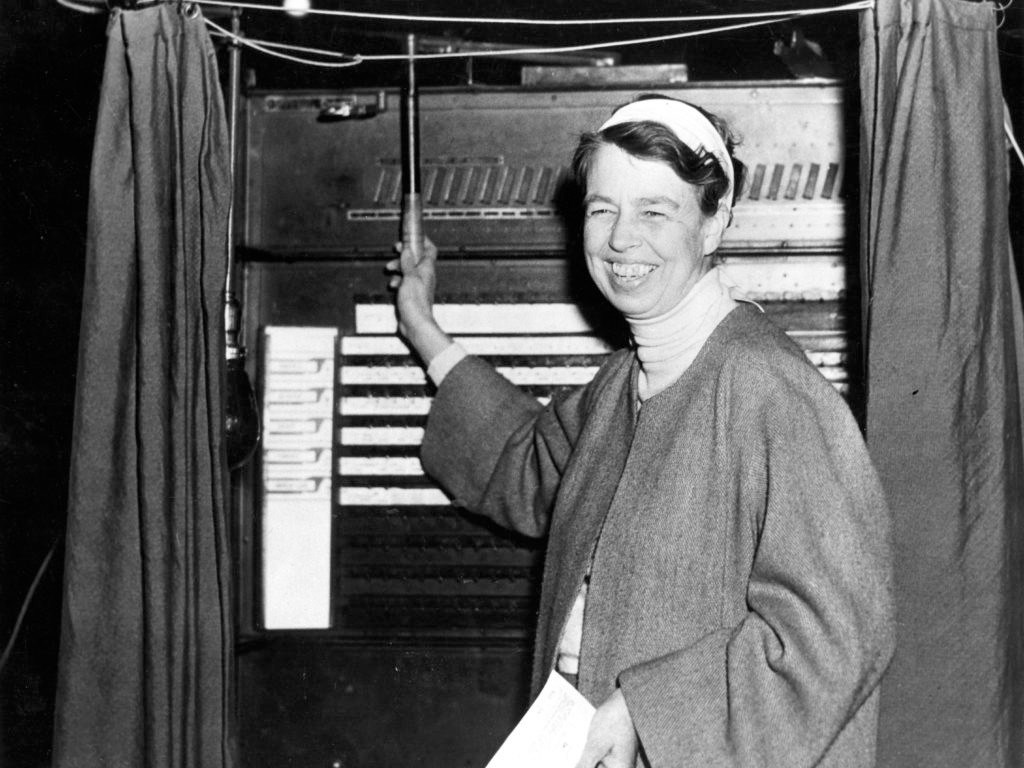Last updated: May 3, 2021
Article
Eleanor Roosevelt and Women's Rights

FDR Library Photo
Looking back on her political development, Eleanor Roosevelt wrote that she had her “first contact with the suffrage movement rather late.” In fact, she did not consider herself a suffragists until 1911, when her husband Franklin D. Roosevelt, then a state assemblyman in New York, came out for women’s right to vote. “I realized that if my husband were a suffragist I probably must be, too.”
It was only in the 1920s that Eleanor Roosevelt became fully involved in the women’s rights movement. Soon after moving back to New York City after the the 1920 presidential election, Roosevelt became a board member of the New York State League of Women Voters and began to direct the League of Women Voters’ national-legislation committee. By mid-decade Roosevelt played a central role in a network of women who led New York’s most influential organizations; including the League of Women Voters, the Women’s Trade Union League (WTUL), the Women’s Division of the New York State Democratic Committee, and the Women’s City Club. She was particularly drawn to the social feminists of the League of Women Voters and the labor feminism of the Women’s Trade Union League. These alliances led to Roosevelt's interest in the poor and working class women, and legislation designed specifically to protect women in the workplace.
As a social feminist and supporter of legislative protections for women, Roosevelt did not endorse the Equal Rights Amendment (ERA). The ERA, a product of Alice Paul and the National Woman’s Party, was an amendment that if ratified would “erase all the laws that discriminated against women.” Roosevelt and her allies believed that an amendment that got rid of all the protective legislation for women in the workplace would do more harm than good. The ERA, she argued, was impractical and ignored political and social realities of sexism and, particularly, the everyday experience of working women. Roosevelt's position on the ERA began to waver in the late thirties, as she felt labor unions and the right to collective bargaining negated the need for protective legislation. However, because of her connections with the WTUL and her friendship with Rose Schneiderman, a leader in the WTUL, Roosevelt did not publicly withdraw her opposition to the ERA until 1946. Even then she held reservations because she believed that there was still a need for protective legislation.
With her move to the White House as first lady in 1932, Roosevelt found she had new sources of power to push for improvements for women’s rights. She worked tirelessly to improve the access women had to New Deal legislation, notably by creating what were known as “she-she-she camps,” or women's organizations of the Civilian Conservation Corps (CCC). Eleanor also held press conferences in which only female journalists could attend—a way she could subtly encourage women to maintain prominent careers.
In the postwar years, Roosevelt continued her advocacy for women’s rights at home and abroad. She continued to support the advancement of women in professional and political positions, and supported the rights of working-class women, through labor unions and other organizations. In 1961, President John F. Kennedy asked Eleanor Roosevelt, who took the Kennedy administration to task for its lack of women in federal appointments, to chair his Presidential Commission on the Status of Women. Eleanor was able to secure the appointment of Pauli Murray, a seasoned activist in the movements for both women’s and African-American rights, to draft the report. Unfortunately, Roosevelt died before the committee’s findings could be reported.
Article prepared by the Eleanor Roosevelt Papers Project.
Tags
- eleanor roosevelt national historic site
- eleanor roosevelt
- val-kill
- women's rights
- women's history
- suffrage
- labor reform
- trade unions
- equal rights amendment
- era
- feminist movement
- john f. kennedy
- pauli murray
- civics
- democracy
- voting rights
- history of labor
- 19th amendment
- civil rights
- women in the labor movement
- women leaders
- women and politics
